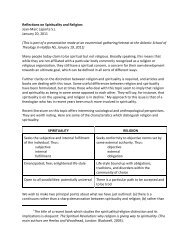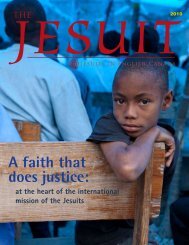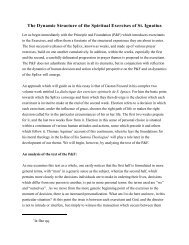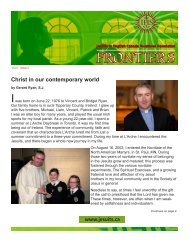Understanding the spiritual journey: from the classical tradition to the ...
Understanding the spiritual journey: from the classical tradition to the ...
Understanding the spiritual journey: from the classical tradition to the ...
You also want an ePaper? Increase the reach of your titles
YUMPU automatically turns print PDFs into web optimized ePapers that Google loves.
sufficient un<strong>to</strong> myself with <strong>the</strong> gifts that I have received, as if <strong>the</strong>y were my ownpossession. 12* An alternate image of moving <strong>to</strong>wards <strong>the</strong> centre, that of <strong>the</strong> labyrinth, has come <strong>to</strong> <strong>the</strong>fore in contemporary <strong>spiritual</strong>ity. It has deep roots. One enters in<strong>to</strong> <strong>the</strong> labyrinth at <strong>the</strong>edge, and goes around in circles <strong>to</strong>wards <strong>the</strong> centre, but at every step of <strong>the</strong> way <strong>the</strong>reare turns, twists, surprises, and <strong>the</strong> centre that may have seemed quite close is still faraway. Every part of <strong>the</strong> area of <strong>the</strong> circle is traversed as one moves <strong>from</strong> <strong>the</strong> startingpoint <strong>to</strong> <strong>the</strong> centre. Many will find this a more congenial description of <strong>the</strong>ir experienceof <strong>spiritual</strong> movement. In rough terms, this movement <strong>to</strong>wards <strong>the</strong> centre is spiral-like,but it allows room for <strong>the</strong> twists and turns in our <strong>spiritual</strong> development which regularspiral movement <strong>to</strong>wards <strong>the</strong> centre does not depict as clearly.1.4.4 O<strong>the</strong>rs will be more comfortable with <strong>the</strong> image of beginning at <strong>the</strong> centre of <strong>the</strong> circleand spiralling, expanding outwards:* Paul tells us that <strong>the</strong> love of God is poured in<strong>to</strong> our hearts by <strong>the</strong> Holy Spirit (Rom 5:5)who is given <strong>to</strong> us. This is <strong>the</strong> beginning: for Paul <strong>the</strong> heart – sometimes referred <strong>to</strong> asspirit – is <strong>the</strong> inmost centre of <strong>the</strong> human person: it is <strong>the</strong>re that <strong>the</strong> person is mostintimately related <strong>to</strong> God.* Once this transformation has taken place, it needs <strong>to</strong> permeate all <strong>the</strong> o<strong>the</strong>r aspects of<strong>the</strong> person, so that ultimately we appear before <strong>the</strong> Lord blameless in spirit, soul(psyche) and body. The psyche is <strong>the</strong> realm of feelings and thoughts, and it may take along time for inner conversion <strong>to</strong> permeate <strong>the</strong> psyche. An alcoholic, for instance, mighthave come <strong>to</strong> <strong>the</strong> inner conversion and submission <strong>to</strong> God in trusting faith that willenable him <strong>to</strong> conquer <strong>the</strong> temptation <strong>to</strong> drink each time it presents itself, but it is veryvery rare that his psyche is attuned <strong>to</strong> his spirit in this matter. The addictive feeling isstill <strong>the</strong>re. If it weren’t, he would be able like o<strong>the</strong>rs <strong>to</strong> enjoy a drink in a moderate way,without undue concern for fostering and developing a bad habit.* The next expansion is <strong>from</strong> spirit <strong>to</strong> body. The body is <strong>the</strong> instrument that allows us <strong>to</strong>communicate with o<strong>the</strong>rs like ourselves and <strong>to</strong>ge<strong>the</strong>r with <strong>the</strong>m establish relationshipsand communities. If we are basically at peace in our hearts and our psyches, we areable <strong>to</strong> build solid self-giving relationships of love with o<strong>the</strong>rs, and build communities ofjustice and peace. This we can more readily do on a more intimate and familial level,but we experience lack of power <strong>to</strong> make of <strong>the</strong> whole world a community of love,where peace and justice reign.12 One can easily enough verify this when one compares what were <strong>the</strong> major issues in ourrelation <strong>to</strong> God as children, adolescents, young adults, mature adults. Things which were major issues inour younger years are relativized and newer, more foundational issues emerge. We would not havebeen ready <strong>to</strong> deal with <strong>the</strong>m, let alone understand <strong>the</strong>m, in our younger years. But our ongoing humanexperience, which urges us <strong>to</strong> reassess our priorities, brings us <strong>to</strong> <strong>the</strong> point were we can deal with <strong>the</strong>m.










